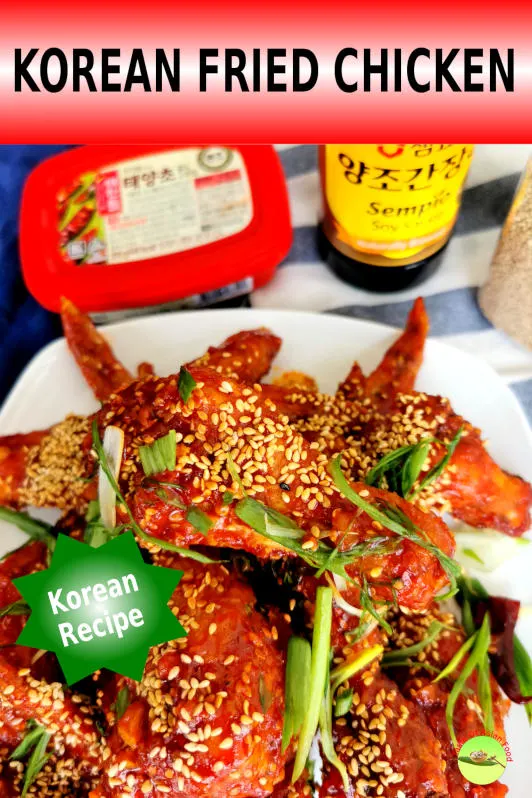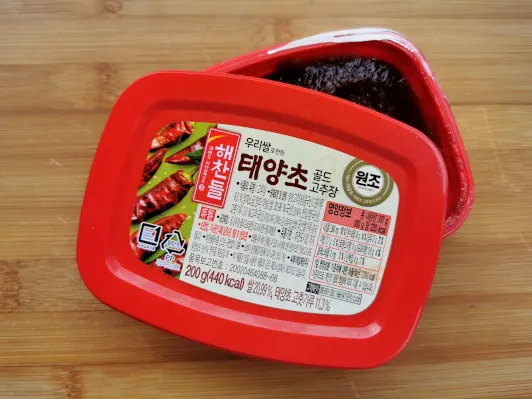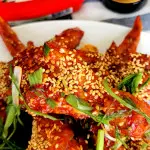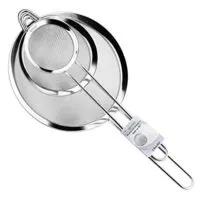If you think fried chicken is only best to serve piping hot right from the deep fryer, think twice. This Korean fried chicken will change your mind.
This Korean fried chicken is glazed with an incredibly savory, punchy, and spicy sauce, yet the coating is still crackling and crunchy even after half an hour! You will expect all these umami, mouthfeel, and the complex flavor attacking your taste buds simultaneously. It is so addictive and submissive even to the most conscious health freaks. It is one of the best fried chicken I ever tasted.
This Korean fried chicken (Dakgangjeong 닭강정) has an exterior that remains crunchy after glazing with a sweet and spicy sauce prepared with the Korean chili paste called Gochujang.
I will explain what Gochujang is in this article. Meanwhile, let’s dive straight into the nitty-gritty how to prepare the Korean fried chicken, Dakgangjeong.

Note: This post may contain affiliate links. Please read my privacy policy for more info. I may receive commissions for purchases made through links in this post. As an Amazon Associate, I earn from qualifying purchases.
1. Marinate the chicken
Marination is a common technique to infuse flavor to meat in most Asian cooking.
The marinate for the Korean fried chicken consists of some fundamental ingredients since the most significant part of the flavor is contributed from the sauce glazing the meat.
The best parts of the chicken are thighs and wings, although any part is suitable.
- Clean the chicken thighs and wings and drain in a colander.
- Dab dry with a paper towel or wipe with a dry cloth. The goal is to keep it dry so that the chicken will be crispy after deep frying.
- Marinate with salt, ground black pepper, and ginger juice for at least one to two hours.
The actual duration of marinating the meat depends on the chicken’s size. Also, it is better to marinate overnight when time is not the issue. You can also pre-marinate and freeze the chicken, which can be kept for several weeks in the freezer.
2. How to fry the crispy chicken
After the chicken pieces are well marinated, remove them from the refrigerator or freezer and wait until it is back to room temperature. If you deep-fry the chicken while it is still cold, the chicken’s inner part may not cook through.
Coat the chicken with potato starch
- Place some potato starch (or cornstarch) in a mixing bowl (80g should be sufficient for 1.2kg of bone-in chicken).
- Add a teaspoon of baking powder and mix well.
- Coat the chicken thoroughly with the starch.
- Remove the chicken to let it rest for five minutes. Then deep it into the starch once more to ensure the surface is entirely covered. This step is to make sure the chicken’s surface is fully protected from the direct heat from the oil. Any exposed part will potentially be overcooked and becomes dry after deep-frying.
Double frying the chicken
There is more about double frying in the next section. Meanwhile, here are the detailed steps.
- Heat adequate oil to 160°C/320°F.
- Shake off any excess starch, place the chicken in the oil to deep-fry for six minutes for the wings, and ten minutes for the drumsticks.
- Do not crowd the chicken pieces in the oil because they will stick together. The coating will break when you pull them apart.
- Remove the chicken after the first round of deep-frying. Let it cool for five minutes.
- Bring the temperature of the oil to 190°C/375°F. Return the chicken to the oil to deep-fry once more until golden.
- Drain the chicken on the rack, and then clean up the excess oil with a paper towel.
3. Make the sweet and spicy sauce
The uniqueness of Korean fried chicken comes from the sauce.
You may not taste anything quite like this unless you are a fan of Korean food. This unique taste comes from the Korean chili paste called Gochujang.
Gochujang is the main component of the sauce, and you should include a generous amount. I also add some dry chili to add some extra capsaicin punch to it.
But it is more than just a hot sauce. There is also ketchup, honey, sugar, soy sauce, vinegar, sesame oil, and sesame seeds.
These ingredients are amalgamated into a complex flavor that can be found only in Korean cuisine.
The honey and sugar thicken the sauce, making it ideal for glazing the chicken’s surface to form a glossy finish.
Here are the steps
- Cut the dry chili into short sections, then remove as many seeds as possible. (Keep the seeds if you like it to be hot and spicy).
- Heat the vegetable oil in a pan, add the dry chili, minced garlic, and ginger. Saute until aromatic.
- Add the ketchup, Gochujang, brown sugar, soy sauce, and vinegar and heat it until it starts to bubble.
- Add some water if it is too thick.
- Remove from heat. Stir in the honey and sesame oil and toasted sesame seeds.
4. Glaze the chicken with the sauce
- Dip each piece of chicken into the sauce to coat it thoroughly. Don’t worry. The crust will remain crunchy with the double frying method.
- Arrange the chicken on a serving plate.
- Drizzle the remaining sauce on the chicken.
- Garnish with more toasted sesame seeds and scallion.
What is Gochujang (Korean chili paste)?
Gochujang (고추장; 苦椒醬; gochu-jang) is an integral ingredient in Korean cooking with a savory, sweet and spicy taste. It is a chili paste made of chili powder, glutinous rice, and fermented soybean powder. The flavor is different from any other chili sauce or chili paste, and there is no exact substitute. Sriracha may be close to it, but it will still taste different. Fortunately, it is now available at most of the Korean Grocery stores and online.
If Gochujang is unavailable, you can use some miso to make it at home since miso is also made with fermented soybean.
Here is the instruction to prepare a homemade version of Gochujang.
- Dissolve 1.25 cups of brown sugar in 1 cup of boiling water.
- After that, add 1/2 cup of chili powder and mix well.
- Next, add 1 cup miso over low heat until the mixture starts to thicken.
- Switch off the stove to let it cool for a minute, add 1 tbsp salt, 1 tsp sake, and 1 tsp rice vinegar.
- Let it cool thoroughly and store in the refrigerator.

Dakgangjeong is the chicken version of the Korean confectionery called Gangjeong. Gangjeong is made by heating the rice syrup and mix with puffed rice, sesame seeds, or nut, then place in the refrigerator until it solidifies. The sauce for dakgangjeong share has similarity to the confectionery, and sometimes it is called candy chicken.
More tips to make the best Korean fried chicken
1. Choice of the chicken parts
Which is the best part of the chicken for Korean fried chicken? Drumsticks and wings are my choices, and a mix of both is even better for presentation.
Chicken breast is the next in line. Since the meat is relatively thicker and tougher than wings, it is recommended to marinate longer or even overnight. Make sure the breast meat is covered with the potato starch coating thoroughly to prevent it from drying out during deep-frying.
2. Potato starch vs. cornstarch vs. flour
While most Korean fried chicken recipes call for potato starch, it may not be readily available at certain places.
In this case, you can substitute it with cornstarch (sometimes labeled as cornflour) on one to one basis. The result by using either one is identical.
Regular flour is not suitable as it will not yield a crunchy coating.
3. Baking powder
The baking powder creates a crunchy crust by increasing the coating’s surface area while releasing gas in hot oil. The air bubbles break up the thick coating, resulting in a light and crispy fried chicken.
A small number of people may be sensitive to it and claim that it has a bitter taste and feels dry on the tongue. Therefore I only add not more than half a teaspoon per 100g of potato starch.
3. Duration of deep-frying the fried chicken
The duration of deep-frying in the recipe only serves as a guide. The actual time depends on the size and the parts of the chicken.
For your reference, I fried the drumsticks for ten minutes at the lower temperature, followed by four minutes at the high temperature. As for the wings, it is 5 minutes, followed by another 3 minutes.
4. The science behind the double frying method
Why is the double-frying method works?
I have read different theories and summarize it as below.
- When you dip the chicken into the oil, the water close to the chicken’s surface starts boiling. Henc, the surface starts to get dryer, forming the crust.
- When the chicken is cool after the first deep fry, the moisture at the inner part of the chicken migrates to the surface, making the surface soggy again. The second fry will boil off this moisture, transforming the surface to an extremely crispy crust.
Therefore, the chicken must be cool for a few minutes to let the internal moisture drift to the surface before executing the second fry.
This double-frying method can crisp up other foods, like making potato chips that crisp outside and moist inside.
Other similar recipes to Korean fried chicken
If you like this Korean fried chicken recipe, you will be interested in the following related recipes.
Japchae is one of the most popular Korean fried noodles. It is prepared with sweet potato glass noodles with a chewy and slippery texture.
The Malaysian Chinese fried chicken is marinated with Chinese five-spice powder and Malaysian curry powder. It is truly a local invention by the Malaysian Chinese.
Chicken Karaage is light and crunchy Japanese fried chicken. Try this recipe if you prefer a lighter flavor.

Korean Fried Chicken
This Korean fried chicken (Dakgangjeong 닭강정) has an exterior that remains crunchy after glazing with a sweet and spicy sauce prepared with the Korean chili paste called Gochujang.
Ingredients
Ingredient A (marinate)
- 1.2kg chicken (thighs and wings)
- 1.5 tsp salt
- 20g grated ginger, use only the juice
- 1/4 tsp ground white pepper
Ingredient B (coating)
- 70g cornstarch
- 1 tsp baking powder
Ingredient C (sauce)
- 2 tbsp vegetable oil
- 3 dry chili, remove seeds, cut into sections
- 2 tbsp minced garlic
- 1 tbsp minced ginger
Ingredient D (sauce)
- 2 tbsp ketchup
- 4 tbsp Gochujang
- 3 tbsp brown sugar
- 1 tbsp soy sauce
- 1 tbsp white vinegar
- 3 tbsp honey (or rice syrup)
- 2 tsp sesame oil
- 1 tbsp toasted sesame seeds
- 1/4 cup of water
Ingredient E (garnish)
- More toasted sesame seeds
- Sliced scallions in short sections
Instructions
- Marinate the chicken with ingredients in A for two hours or longer.
- Mix ingredients in B as the coating for the chicken.
- After marinating, coat the chicken with B, rest for five minutes, and coat again to thoroughly cover it.
- Deep-fry at 160°C/320°F. (wings = 6 minutes, drumsticks = 10 minutes).
- Remove from oil and let the chicken cool for five minutes.
- Deep-fry for the second time at 190°C/375°F. (wings = 3 minutes, drumsticks = 4 minutes).
- Remove and drain on the rack, then clean up the excess oil with a paper towel.
- Heat the vegetable oil in a pan, saute ingredients in C until aromatic.
- Add ingredients in D to the pan. Bring it to a boil and reduce to a thick sauce.
- Coat the chicken with the thick sauce.
- Arrange the chicken on the plate, drizzle the remaining sauce on it (if there is leftover).
- Garnish with more toasted sesame seeds and scallion.
Recommended Products
As an Amazon Associate and member of other affiliate programs, I earn from qualifying purchases.
Nutrition Information:
Yield: 12 Serving Size: 1Amount Per Serving: Calories: 494Total Fat: 26gSaturated Fat: 7gTrans Fat: 0gUnsaturated Fat: 16gCholesterol: 119mgSodium: 1244mgCarbohydrates: 30gFiber: 1gSugar: 15gProtein: 34g
This data was provided and calculated by Nutritionix on 12/8/2020




Delight Your Taste Buds With Flavorful Korean Bbq Chicken Sliders – ercis-board.com
Saturday 3rd of May 2025
[…] The recipe starts with high-quality chicken chunks marinated in a blend of soy sauce, garlic, ginger, and a touch of sweetness from brown sugar or honey, complemented by the heat of gochujang. This mixture ensures that each bite packs a flavorful punch that’s characteristic of authentic Korean BBQ chicken. […]
Veenas
Friday 18th of December 2020
Nice Blog !! A Very Yummy Wonderful Recipe !!! WOW Nice Photos to See. I'll Definitely Try it. Thank You for Sharing that Lovely Food.
KP Kwan
Saturday 19th of December 2020
Thank you. It's my pleasure to share.
Opn024
Wednesday 16th of December 2020
In step 3 do you mean coat in "d" or is it supposed to be "b". I have used recipe swapping d for b in step 3 and turned out perfect. Great recipe, just an editing mistake i assume.
KP Kwan
Wednesday 16th of December 2020
Thank you for spotting the error. It is B, not D, and it has been corrected.
Gillian
Tuesday 8th of December 2020
Hi, can I air-fried the chicken instead?
KP Kwan
Wednesday 9th of December 2020
Hi Gillian, I have never tried using an air fryer, but interested to know whether the double frying method can be applied to air frying. If you have tried, appreciate you can share the result with us. KP Kwan
KP Kwan
Tuesday 8th of December 2020
Hi, this is KP Kwan. I am happy to see you in this comment area, as you have read through my recipe. I am pleased to reply to any questions and comments as soon as possible.